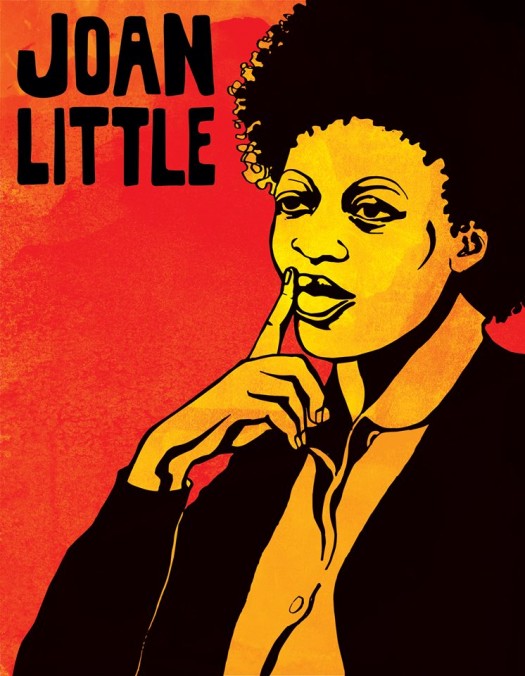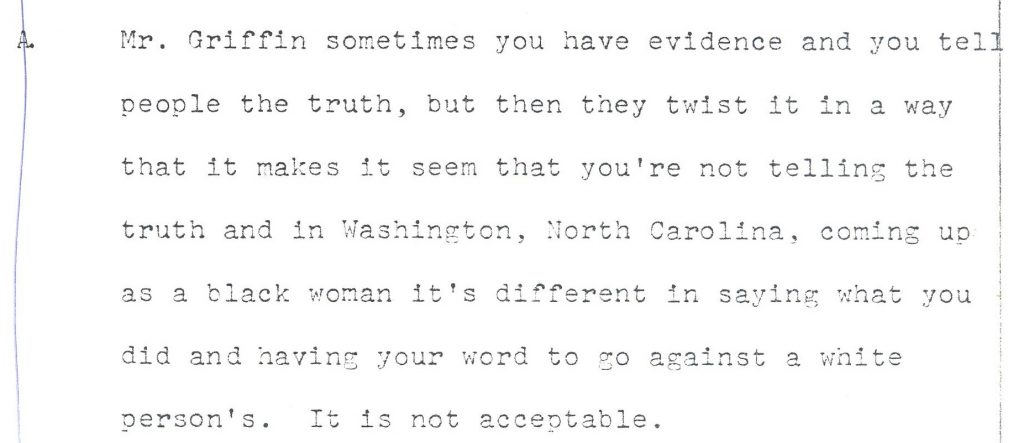In June of 1974, a 21-year-old black woman was placed in a Beaufort County jail on a breaking and entering charge. By August of that same year, she was on the run after one of her white jailers, Clarence Alligood, was found dead in her cell, stabbed multiple times with an ice pick and naked from the waist down. After a week on the run, Little turned herself in and what followed was a fascinating clash of southern mores, international topics of activism, and the dark truths about the American criminal justice system. On the 43rd anniversary month of the start of the ordeal, this post intends to highlight how the case is documented in the Southern Historical Collection, various interpretations of the material, and why it is a significant part of our manuscript collection.

The Southern Historical Collection has a small collection of materials on the Joan Little murder trial sold to us by James Reston Jr., a Creative Writing lecturer1 at UNC-Chapel Hill in March of 1976. Reston based his book, The Innocence of Joann Little: A Southern Mystery (1977) on this material. The collection includes transcripts of key witness testimonies from the defense and prosecution as well as news clippings and recorded interviews from significant participants in the trial. Reading through the transcripts, a researcher can put him or herself in the front seat of the courtroom. We learn how Alligood propositioned Joan repeatedly before the murder; we feel how Joan’s voice falters when she must relive her assault on the witness stand (Figure 1); we hear the crass interrogation as the prosecution tries to vilify Joan with assumptions about her sexual history and criminal lifestyle.

Although it is easy for general audiences to be drawn to this case because of its ties to racism, sexism, classism, the criminal justice system, and sexual assault – there is much more to unpack. Many scholars have delved deeper into the broader historical, legal, and societal issues that make this a landmark case. For example, in “She Ain’t No Rosa Parks: The Joan Little Rape-Murder Case and Jim Crow Justice in the Post-Civil Rights South”, Christina Greene discusses how we may not want celebrate Joan’s acquittal in a southern courtroom as a sign of progress too quickly. On page 429, she reminds us that many poor black women without the national attention or high caliber defense team are being crushed by the same systems that almost crushed Little.
Genna Rae McNeil’s article sums up many aspects of my interest in this case with her essay; The Body, Sexuality, and Self-Defense in State vs. Joan Little, in which she discusses the many important ways that Joan Little maintained her integrity and defended herself throughout the ordeal (p. 237). All accounts confirm that her personal life was challenging before her imprisonment (leaving home at an early age, not finishing high school, and falling in with a dangerous crowd) but she did not let those obstacles or how people may have perceived her control her future. She could have let that jailer rape her and follow through with her plans to get out of jail on bond for her breaking and entering charge in the weeks ahead. She could have fled the country when she escaped from jail, she certainly had enough lead time and connections to keep herself hidden for a long period. She could have fallen apart under the trauma of it all. She didn’t do any of these things, she fought for her life, she turned herself in, and in the trial, she withstood attacks on her character and spoke her truth (Figure 2). This woman embodies what it means to be free – which is probably why her story resonated with so many types activist groups.

There is no doubt that the SHC curators in 1974 saw the widespread appeal of Reston’s archival materials on Joan Little. “Women’s groups saw it as a test of a woman’s right to self-defense in a sexual attack. Civil Rights groups looked to it as a test of Southern justice for blacks. Prison reform advocates supported it as an inmate’s rights issue (from staff & wire reports, N&O 08/18/1975)”. In addition to these papers, the trial is well documented in other Wilson Library resources. There are over 40 folders of content from the trial in the Hamilton Hobgood (judge) papers. Access to North Carolina newspapers from Beaufort and Wake Counties as well as others throughout the state can be found on microfilm in the North Carolina Collection. Bernice Johnson Reagon’s song about Joan Little is featured on a Sweet Honey in the Rock album in the Southern Folklife Collection. This woman and her trial represent an important episode in our collective histories and I would challenge all of us to consider what her story means to each of us and why it matters.
